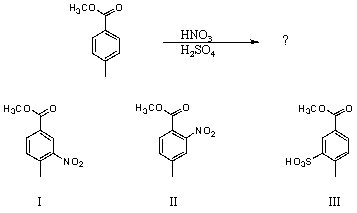Multiple Choice
Which would be the major product(s) of the following reaction? 
A) I
B) II
C) III
D) I and II in roughly equal amounts.
E) I and III in roughly equal amounts.
Correct Answer:

Verified
Correct Answer:
Verified
Q116: S<sub>N</sub>1 solvolysis of C<sub>6</sub>H<sub>5</sub>CH=CHCH<sub>2</sub>Cl in water produces:<br>A)C<sub>6</sub>H<sub>5</sub>CH<sub>2</sub>C(OH)=CH<sub>2</sub><br>B)C<sub>6</sub>H<sub>5</sub>CH=CHCH<sub>2</sub>OH<br>C)C<sub>6</sub>H<sub>5</sub>CHOHCH=CH<sub>2</sub><br>D)A
Q117: Draw a mechanism that explains the formation
Q118: The electrophilic bromination or chlorination of benzene
Q119: Acid-catalyzed hydration of 1-phenyl-1-pentene gives 1-phenyl-1-pentanol almost
Q120: What would you expect to be the
Q122: The compound 4-bromo-1-propylbenzene is best made from
Q123: Which is the best sequence of reactions
Q124: Which of the following contributors to the
Q125: What would be the product of the
Q126: Based on your knowledge of electrophilic aromatic